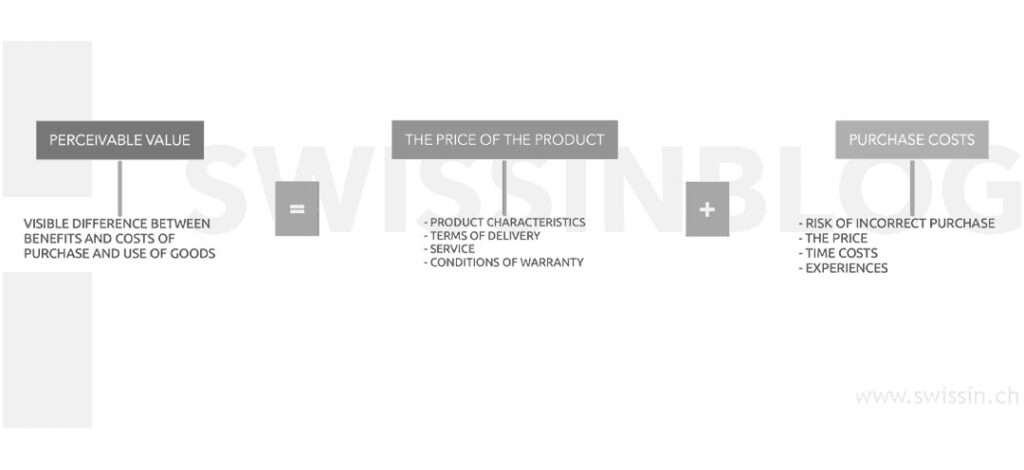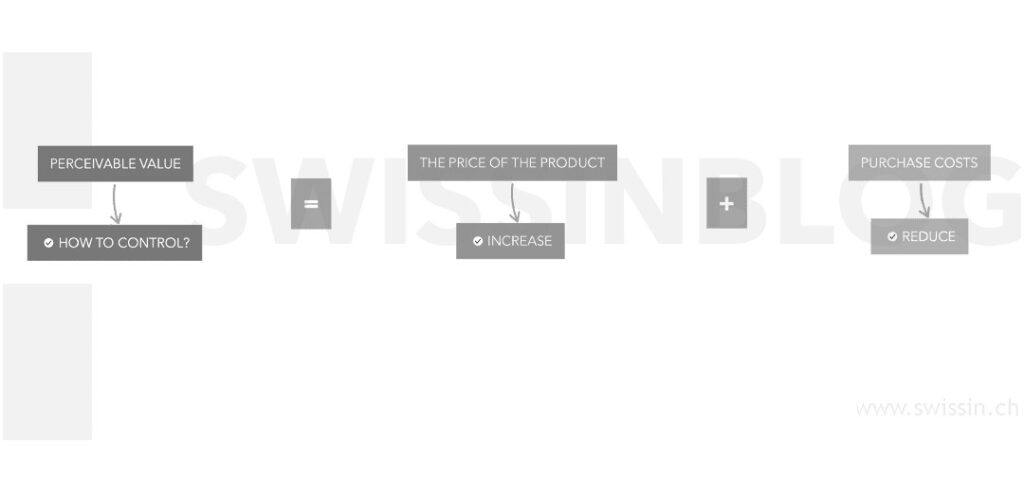—
The theory of consumer value of goods helps to answer the question “Which of the goods is most likely to be bought by the consumer and why?”. The theory is based on the hypothesis that the buyer chooses the product that has the greatest value for him – which is why such a theory is often called: Perceived value pricing.
The consumer always has his own personal idea of the real value of the product which comprises several parameters: characteristics and appearance of the product, level of service, brand image, competence of the staff, risks of making an incorrect purchase.
UNIVERSAL FORMULA
The formula for determining the perceived value of a product is:

Perceived value is the difference between the value of a product and the total costs incurred by a consumer when buying a product where the value of a commodity is the sum of all the benefits that the buyer receives when purchasing the goods, and the costs of consumption are the risks that the consumer expects to suffer when buying and using a company product.
The value of the goods includes: the characteristics of the goods (quality, a set of functions, reliability, service life, attractiveness), conditions of warranty or after-sales service, quality of service, staff competence, terms and quality of delivery, general corporate image of the company.
Testing the costs of consumption, the consumer tests the following costs: time costs, financial costs, costs of emotions, the risk of making a wrong purchase, the risk of not accepting a purchase by the reference group.
Perceived value and strategy of the company.
According to the theory of perceived value, a company must reduce the cost of consumption and increase the value of a product in the eyes of the consumer until its product has the highest value compared to its competitors. If the perceived value is lower than that of the competitor, then the price of the product must also be lower than that of the competitor until the characteristics and image of the product will be higher.

How to reduce consumption costs?
Costs of consumption must be reduced by minimizing the risks that the consumer bears when buying and using products, for example:
– Provide an opportunity to test the product before purchase or reduce the prices for the first purchase – such measures will reduce the financial risks of the buyer (risk of waste of money and purchase of a low-quality product);
– Simplify the purchase process, reduce the duration of the purchase – such measures will reduce the time costs of the client and make the purchase more pleasant;
– Provide complete, clear information about the product;
– Invest in growing brand awareness to increase product confidence, inform about product characteristics and reduce the risk of making an incorrect purchase.
How to increase the perceived value of the product?
Increasing the perceived value of the purchase is to create an attractive product, the formation of the correct first impression of the product, for example:
– Improving the appearance of the product, creating a beautiful, attractive product packaging;
– Giving the product image characteristics valuable to the target audience;
– Improving product quality, increasing functions;
– Using attractive texts that sell the product;
– Conducting an advertising campaign to improve the image of the product and raise awareness of the product.
Assessment of perceived value.
There are 2 ways to assess and determine perceived value: a survey and comparative analysis.
A survey. Just ask the consumer about how much, in his opinion, a product from Brand X can cost with a set of XX characteristics and compare the price with a competitor.
The second method is a more complex comparative analysis of the company’s goods with competitive products:
– To conduct a comparative analysis of all characteristics of the product with competitors, (the analysis should include all the parameters and values of the products);
– To conduct a comparative analysis of all costs of products with competitors;
– For each parameter taking part in the analysis, write the level of importance (from 1 to 5, although the scale can be any);
– Compare the amount of points with competitive products.
—
The theory of consumer value of goods helps to answer the question “Which of the goods is most likely to be bought by the consumer and why?”. The theory is based on the hypothesis that the buyer chooses the product that has the greatest value for him – which is why such a theory is often called: Perceived value pricing.
The consumer always has his own personal idea of the real value of the product which comprises several parameters: characteristics and appearance of the product, level of service, brand image, competence of the staff, risks of making an incorrect purchase.
UNIVERSAL FORMULA
The formula for determining the perceived value of a product is:

Perceived value is the difference between the value of a product and the total costs incurred by a consumer when buying a product where the value of a commodity is the sum of all the benefits that the buyer receives when purchasing the goods, and the costs of consumption are the risks that the consumer expects to suffer when buying and using a company product.
The value of the goods includes: the characteristics of the goods (quality, a set of functions, reliability, service life, attractiveness), conditions of warranty or after-sales service, quality of service, staff competence, terms and quality of delivery, general corporate image of the company.
Testing the costs of consumption, the consumer tests the following costs: time costs, financial costs, costs of emotions, the risk of making a wrong purchase, the risk of not accepting a purchase by the reference group.
Perceived value and strategy of the company.
According to the theory of perceived value, a company must reduce the cost of consumption and increase the value of a product in the eyes of the consumer until its product has the highest value compared to its competitors. If the perceived value is lower than that of the competitor, then the price of the product must also be lower than that of the competitor until the characteristics and image of the product will be higher.

How to reduce consumption costs?
Costs of consumption must be reduced by minimizing the risks that the consumer bears when buying and using products, for example:
– Provide an opportunity to test the product before purchase or reduce the prices for the first purchase – such measures will reduce the financial risks of the buyer (risk of waste of money and purchase of a low-quality product);
– Simplify the purchase process, reduce the duration of the purchase – such measures will reduce the time costs of the client and make the purchase more pleasant;
– Provide complete, clear information about the product;
– Invest in growing brand awareness to increase product confidence, inform about product characteristics and reduce the risk of making an incorrect purchase.
How to increase the perceived value of the product?
Increasing the perceived value of the purchase is to create an attractive product, the formation of the correct first impression of the product, for example:
– Improving the appearance of the product, creating a beautiful, attractive product packaging;
– Giving the product image characteristics valuable to the target audience;
– Improving product quality, increasing functions;
– Using attractive texts that sell the product;
– Conducting an advertising campaign to improve the image of the product and raise awareness of the product.
Assessment of perceived value.
There are 2 ways to assess and determine perceived value: a survey and comparative analysis.
A survey. Just ask the consumer about how much, in his opinion, a product from Brand X can cost with a set of XX characteristics and compare the price with a competitor.
The second method is a more complex comparative analysis of the company’s goods with competitive products:
– To conduct a comparative analysis of all characteristics of the product with competitors, (the analysis should include all the parameters and values of the products);
– To conduct a comparative analysis of all costs of products with competitors;
– For each parameter taking part in the analysis, write the level of importance (from 1 to 5, although the scale can be any);
– Compare the amount of points with competitive products.
IMPORTANT:
We often use the theory of customer value to set a competitive price for a product. When setting prices, manufacturers pay attention to the difference between perceived value and the real value of the product:
– If PV (perceived value) is higher than real value, then such a product will be attractive to consumers;
– If PV is lower than the cost of the product, then such a product will cause alertness to the consumer;
– A product that has a higher difference between the PV and the real value is more likely to be purchased by the target audience.
0 Comments